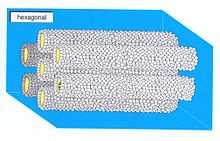Hexagonal phase

A hexagonal phase of lyotropic liquid crystal is formed by some amphiphilic molecules when they are mixed with water or another polar solvent. In this phase, the amphiphile molecules are aggregated into cylindrical structures of indefinite length and these cylindrical aggregates are disposed on a hexagonal lattice, giving the phase long-range orientational order.
In normal topology hexagonal phases, which are formed by type I amphiphiles, the hydrocarbon chains are contained within the cylindrical aggregates such that the polar-apolar interface has a positive mean curvature. Inverse topology hexagonal phases have water within the cylindrical aggregates and the hydrocarbon chains fill the voids between the hexagonally packed cylinders. Normal topology hexagonal phases are denoted by HI while inverse topology hexagonal phases are deonted by HII. When viewed under a polarising microscope, thin films of both normal and inverse topology hexagonal phases exhibit birefringence, giving rise to characteristic optical textures. Typically, these textures are smoke-like, fan-like or mosaic in appearance. The phases are highly viscous and small air bubbles trapped within the preparation have highly distorted shapes.
-

smokey optical texture of type I hexagonal phase
-

mosaic optical texture of type I hexagonal phase
-

mosaic/focal conic optical texture of type I hexagonal phase